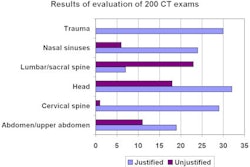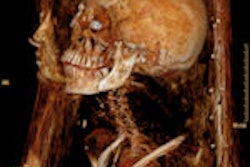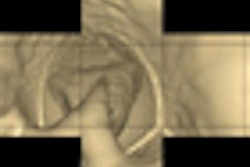A campaign to track and reduce CT dose, especially for pediatric applications, has been gaining momentum, with significant attempts to educate physicians about the radiation risks of CT procedures. But how successful has the effort been? And what kinds of dose-reducing strategies are radiologists using?
At the 2008 RSNA meeting in Chicago, Dr. Ella Kazerooni and colleagues at the University of Michigan Health System in Ann Arbor reported results from the CT Awareness of Radiation Exposure Study (CARES), which assessed radiologists' awareness and use of CT dose-reduction technologies across a variety of practice settings.
One hundred fifty radiologists from community hospitals, academic hospitals, and outpatient imaging centers completed a Web-based survey about awareness, availability, and use of CT dose-reduction technologies in the past six months. The technologies included reducing mA and kV, prospective gating/triggering, dose modulation, and 3D dose modulation.
The researchers found that 97% of the radiologists who participated in the study knew about CT low-dose technologies. Sixty-six percent reported having access to these kinds of technologies, and 55% reported using them. Of this 55%, 73% of radiologists from academic hospitals, 49% from community hospitals, and 53% from outpatient imaging centers used dose-lowering technology.
The study showed that low-dose CT technology was used for 14% of CT exams, on average. Reducing mA was the most common technique (47%), followed by reducing kV (45%), gating/triggering and dose modulation (23% each), and 3D dose modulation (7%).
Although 40% of the radiologists who participated in the study said they had access to newer dose-reduction techniques such as dose modulation, prospective electrocardiogram triggering, and 3D dose modulation, only 29% said they used these techniques.
Across all the practice types, the most common CT exams for which any dose-lowering technology was used were cardiac (29%), chest (21%), abdominal (12%), and pelvic (12%). The participating radiologists rated CT dose minimization lower in importance than image quality, diagnostic confidence, the need to repeat scans, perception of offering the latest technologies, patient throughput and comfort, and cost per scan/cost savings. Few reported that the ability to offer low-dose CT scans increased referrals (13%) or patient satisfaction (8%).
Despite high awareness of dose-reduction technologies for CT, radiologists aren't using them, according to Kazerooni.
"Radiologists are aware of low-dose technology: two-thirds have it in their practices, just over half use it. But only 14% of CT examinations take advantage of it," she said.
By Kate Madden Yee
AuntMinnie.com staff writer
February 23, 2009
Related Reading
320-detector-row CT cuts dose in triple rule-out exams, February 12, 2009
Image Gently organizers look ahead on one-year anniversary: Part 1, February 6, 2009
JAMA study finds wide variation in cardiac CTA dose, February 3, 2009
Lower radiation dose safer, still effective for acoustic neuromas, January 19, 2009
Significant VC dose reduction possible with undersampling, December 19, 2008
Copyright © 2009 AuntMinnie.com



















